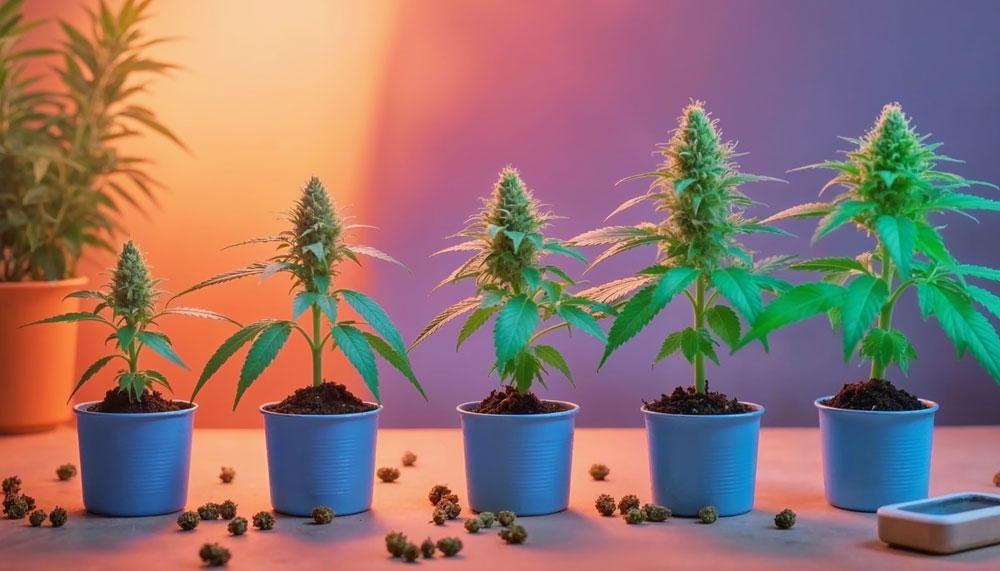In this article you will find answers to the following questions: What is crop rotation? How does soil-based cultivation work? Why is soil health important in agriculture? What are the consequences of nutrient depletion in soil? What are the principles behind crop rotation? What are the benefits of implementing crop rotation? How does crop diversity contribute to sustainable agriculture? What are some effective strategies for crop management? Why is maintaining soil fertility crucial for farming?
In the art of soil-based cultivation, the selection of the right cannabis seeds is an integral part of the process. Just as crop rotation plays a crucial role in maintaining soil health and preventing nutrient depletion, choosing the appropriate marijuana seed strain ensures a harmonious and thriving garden ecosystem. When planning your crop rotation, consider the unique characteristics of different cannabis seeds strains. Opt for strains that complement each other’s nutrient needs and growth patterns, enhancing the overall success of your cultivation efforts. By carefully curating a diverse collection of marijuana seeds, you can embrace the principles of sustainable agriculture while enjoying the abundant benefits that crop rotation and thoughtful strain selection bring to your soil-based garden.

As an enthusiastic grower, you’re already familiar with the wonders of cultivating plants in soil. It’s a journey that requires passion, dedication, and a wealth of knowledge. Today, we delve into a crucial aspect of successful soil-based cultivation: crop rotation. In this comprehensive guide, we’ll explore the principles and benefits of crop rotation and how it contributes to maintaining soil health and preventing nutrient depletion.
Caring for your soil should be a top priority for every grower. Healthy soil harbors beneficial microorganisms, retains moisture, and allows plants to access vital nutrients. As you embark on your cannabis growing journey, remember that a healthy and balanced soil ecosystem lays the groundwork for success.

7. Selecting Suitable Crops for Rotation
Choosing the right crops to rotate is a pivotal step. Aim for a diverse selection that includes both annual and perennial plants. Popular choices for rotation include legumes, grains, brassicas, and cover crops. Each of these groups brings unique benefits to the soil and supports the growth of subsequent crops.
8. Crafting a Crop Rotation Plan
To create an effective rotation plan, divide your garden into sections or beds. Assign each section to a specific crop or crop family, and then rotate the crops within that section annually. Avoid planting crops from the same family in the same spot for at least three years.
9. Timing and Sequence
Timing is crucial in crop rotation. Plan your rotations according to the growing season and the life cycles of the plants. Consider the duration of each crop’s growth and ensure you leave enough time for soil replenishment before planting the next crop.
10. Managing Nutrient Depletion
As you nurture your garden with various crops, some will inevitably deplete specific nutrients from the soil. Combat nutrient depletion by incorporating nutrient-rich cover crops or organic matter during fallow periods. Composting kitchen scraps and yard waste can also contribute to nutrient recycling.
11. Embracing Sustainable Practices
Incorporate sustainable practices alongside crop rotation to maximize its benefits. Utilize compost, mulch, and organic fertilizers to nourish your soil. Reduce the use of chemical pesticides and instead encourage beneficial insects to thrive in your garden.

In this comprehensive article, we delve into the principles and benefits of crop rotation in soil-based cultivation, shedding light on its significant role in maintaining soil health and preventing nutrient depletion. Crop rotation, an ancient agricultural practice, involves systematically altering the types of crops grown in specific areas over time, breaking the cycle of continuous planting of the same crop in the same spot. By embracing this practice, growers can enhance soil fertility through the balanced nutrient demands of different crops. Furthermore, crop rotation acts as a natural pest and disease management strategy, disrupting the life cycles of harmful organisms while promoting biodiversity. The incorporation of weed-suppressive crops offers an eco-friendly approach to weed management, reducing the need for chemical interventions. Moreover, by alternating crop families, gardeners can mitigate soil exhaustion and optimize water usage, ensuring a thriving garden ecosystem even during dry spells. Crop rotation aligns with the principles of sustainable agriculture, conserving resources and supporting long-term soil health. Understanding the timing, sequence, and nutrient needs of various crops allows for effective planning and management of the rotation process. By adopting sustainable practices alongside crop rotation, such as utilizing compost, mulch, and organic fertilizers, growers can further nurture soil health and create a foundation for successful, bountiful harvests. Embrace this expert guide to master the art of soil-based cultivation and reap the rewards of a thriving and sustainable garden ecosystem.
Remember, your journey as a grower is a continuous learning process. Keep experimenting, observing, and adapting your approach to meet the unique challenges and opportunities that arise in your garden.













Related Posts

If you want healthy cannabis plants with high yields and potent buds, using the best nutrients for weed plants is essential. Unlike regular houseplants or vegetables, cannabis has unique nutrient needs at different growth stages.

Welcome to the exciting world of cannabis and cryptocurrency! BTC and marijuana make the perfect match, offering a seamless and secure way to purchase weed seeds and accessories.

As a grow shop – garden center owner from Amsterdam and a passionate cannabis cultivator, I understand the importance of providing the right nutrients to your weed plants at different stages of growth. Proper nutrition is crucial for healthy and thriving cannabis plants, ultimately leading to higher yields and potent buds. In this guide, we will explore the essential nutrients…